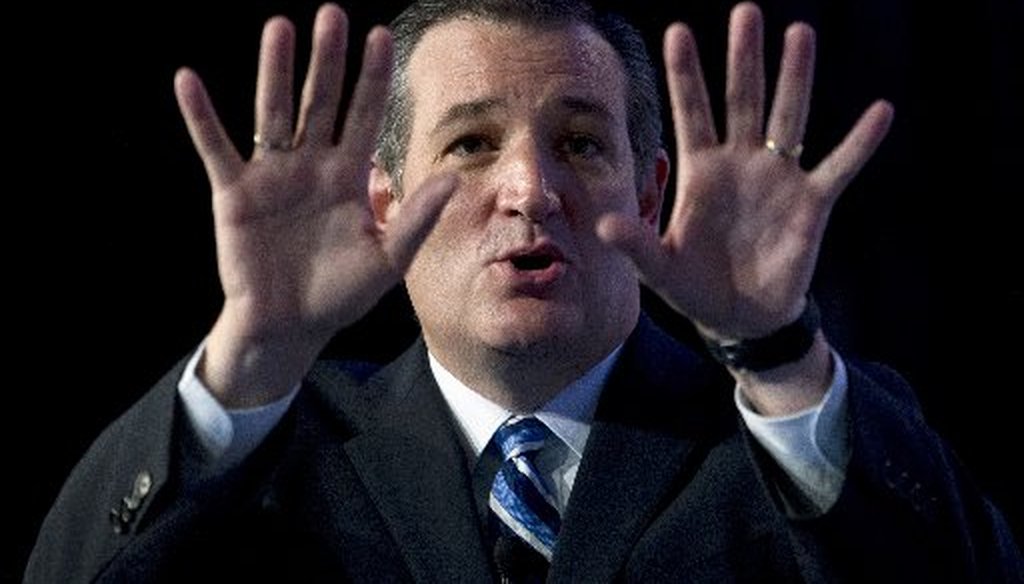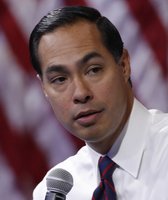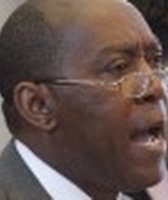Stand up for the facts!
Our only agenda is to publish the truth so you can be an informed participant in democracy.
We need your help.
I would like to contribute

Our fact checks of Texan Ted Cruz and stories about him dominated the PolitiFact Texas top 10 for September (Associated Press photo).
Sen. Ted Cruz says the Democratic Party is shrinking
After the first Democratic presidential debate Oct. 13, 2015, Texas Republican Ted Cruz interpreted the crowd’s cheers for proposals to raise taxes as a reason for the decline of the Democratic Party.
The day after the debate, Fox News’ Megyn Kelly asked Cruz how he could appeal for votes from Americans cheering on Bernie Sanders, the Vermont senator seeking the Democratic nomination, who has stressed how much more the very wealthiest Americans have than the rest of us.
"Well," Cruz replied, "it's why the modern Democratic Party is getting smaller and smaller and smaller. What does it say that they're having a hard time finding anyone to run for president who isn't nearly 207 years old? You're not getting new and fresh ideas."
Ahem: Sanders is 74; fellow Democratic candidate Hillary Clinton is 68. And while we’re not going to gauge how Cruz appeals for more Democratic support, we did wonder if the Democratic Party is shrinking, as Cruz said.
Cruz’s campaign spokesman said Cruz based his statement on the losses the Democratic Party suffered in recent elections. "Cruz is referring to all the Senate seats, House seats, governors and state legislative seats lost during this administration," said Rick Tyler, Cruz for President’s national spokesman.
Democrats losing steam under Obama?
Measuring the exact membership or size of either national party is difficult. Some states, including Texas, do not require voters to register with any party. As University of Texas-Austin government professor Brian Roberts, who studies American political institutions and interest groups, told us, there’s "no easy answer."
But certain measures can give a relative sense of party size, despite variations in registration rules. University of Texas-Austin government professor Sean Theriault, who studies congressional decision-making and has published books on the power of the electorate and party polarization. He suggested three measurements for evaluating the size and strength of political parties: the party in the government, the party in the electorate and party organizations.
The first component we looked at was the Democrats’ total electoral seats. That is what Cruz’s campaign spokesman said Cruz was referring to in his comment.
During Obama’s administration, Democrats have lost 13 U.S. Senate seats, 69 House seats, 11 governorships, and 910 state legislative seats.
Another way to look at a party's health is the number of voters who claim affiliation. Based on this data, the Democratic Party’s support in the electorate fluctuates, but generally is stable. A Gallup poll measuring trends in party identification since 2004 found that 29 percent of Americans identified as Democrats in October 2015. In January 2004, when the poll data begins, 28 percent of Americans identified as Democrats. The 11-year high was 38 percent in March 2008 and March 2009. The poll asks respondents, "As of today, do you consider yourself a Republican, a Democrat, or an independent?"
For comparison, in October 2015, 25 percent of Americans identified as Republicans, and 42 percent identified as independents. Support for the Republican Party hit a high of 39 percent in September 2004.
Each party’s voter demographics also suggest changes in size ahead. According to a 2014 Pew Research Center study, 51 percent of Millennials identified as Democrats in 2014, compared to their Republican peers’ 35 percent — the highest margin of any generation. The Democratic Party also claims more members among Generation X and Baby Boomer voters, by smaller margins.
The only demographic in which Republicans have the advantage is the Silent Generation, with 47 percent identifying with the Republican Party, compared to 43 percent with the Democratic Party. That the country’s oldest voters are the only ones to lean Republican and that its youngest voters lean Democrat by a strong margin suggests growth for the Democratic Party, while the Republican Party’s strongest demographics are aging out.
Party organizations, and their success in fundraising, are also a component of a political party’s health or size. In the 2010 off-year election cycle, the national Democratic Party raised $817.5 million. In the 2014 election cycle, the most recent available, the party raised $855 million, which suggests an increase of $37.5 million in the 2014 election cycle, according to OpenSecrets.org.
Factoring in funds raised through the Democratic National Committee, the Democratic Congressional Campaign Committee and other party organizations, Theriault said, "the Democratic Party "is getting bigger and is bigger than the Republican Party."
For comparison, the Republican Party raised $586,978,840 in 2010 and $665,608,564 in 2014.
Our ruling
Cruz said that the "Democratic Party is getting smaller and smaller and smaller."
Democrats have lost a significant number of seats and federal and state offices throughout the Obama administration. The party as a whole, however, is stable or has grown both in terms of the electorate and its party organizations.
Cruz’s claim is partly accurate, but leaves out important context about the Democratic Party beyond its elected officials. We rate this claim Mostly False.
MOSTLY FALSE – The statement contains an element of truth but ignores critical facts that would give a different impression.
Click here for more on the six PolitiFact ratings and how we select facts to check.
Our Sources
Election cycle financial data, Political Parties, OpenSecrets.org
Poll, Party Affiliation, Gallup
Data, Trends in Party Identification 1939-2014, Pew Research Center, April 7, 2015
Data, Party Identification Trends, 1992-2014: Generation, Pew Research Center, April 7, 2015
Data, Party Identification 1952-2012, American National Election Study
Truth-O-Meter article, Have Democrats lost 900 seats in state legislatures since Obama has been president?, PolitiFact, Jan. 25, 2015
Interview transcript, Ted Cruz, Ben Carson sound off on first Democratic debate, Fox News, Oct. 14, 2015
Email interview with Rick Tyler, national spokesperson, Cruz presidential campaign, Oct. 22, 2015
Email interview with Ruth Guerra, Director of Hispanic Media, Republican National Committee, Oct. 23, 2015
Phone and email interview with Miryam Lipper, Deputy National Press Secretary and Director of Broadcast Media, Democratic National Committee, Oct. 23, 2015
Email interview with Sean Theriault, government professor, University of Texas-Austin, Oct. 23, 2015
Email interview with Brian Roberts, government professor, University of Texas-Austin, Oct. 23, 2015
Email interview with Justin Esarey, assistant professor of political science, Rice University, Oct. 23, 2015
Browse the Truth-O-Meter
More by Emma Hinchliffe
Sen. Ted Cruz says the Democratic Party is shrinking
Support independent fact-checking.
Become a member!
In a world of wild talk and fake news, help us stand up for the facts.















































